Scientific name: Penstemon strictus
Common names: Rocky Mountain penstemon, Rocky Mountain beardtongue, beardtongue
Family scientific name: Plantaginaceae
Family common name: plantain
Article and photos by Janice Tucker
Summer will soon come calling to Northern New Mexico, bringing with it a full complement of wildflowers that will grace the natural landscape and fill flower beds in home gardens for several months to come. The Rocky Mountain penstemon (Penstemon strictus) with its hues of purple to light blue flower spikes and handsome, dark green foliage will be among the first of the season’s wildflowers to usher in the season.
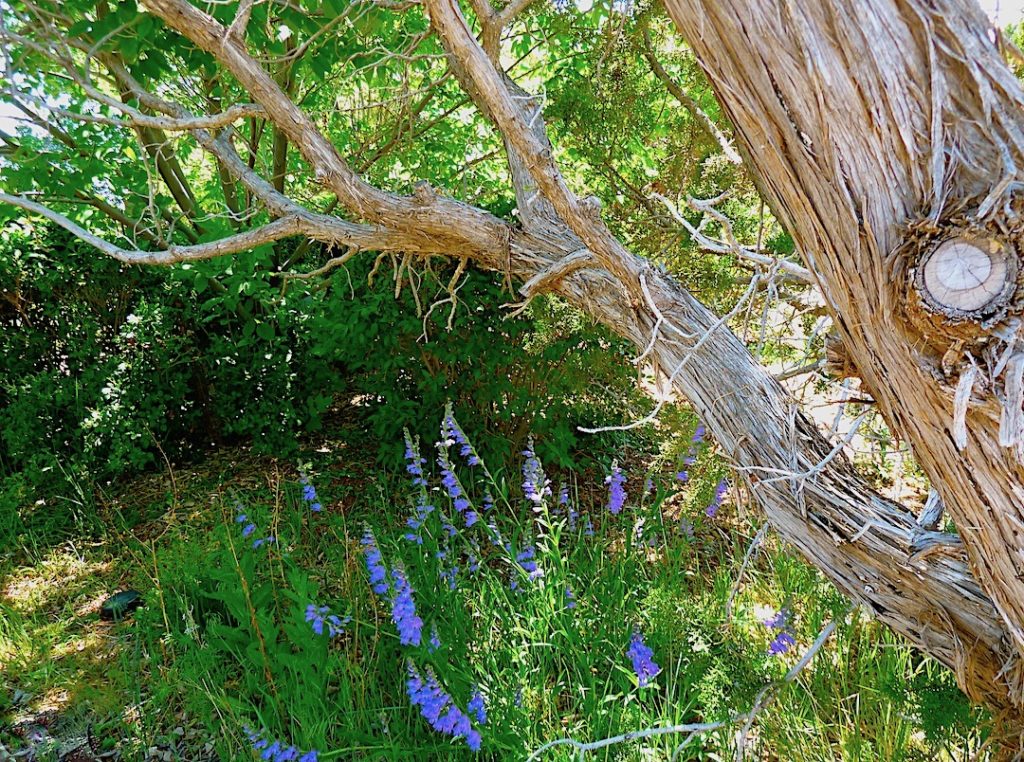
Rocky Mountain penstemon under juniper. Photo by Janice Tucker.
In the United States the Rocky Mountain penstemon (P. strictus) is native to New Mexico, Arizona, Utah, Colorado, Wyoming and a bit of Nevada. During the spring and summer its purple blooms lend a dramatic splash of color to fields, roadsides, piñon-juniper forests, and high montane regions. This perennial wildflower frequently sneaks into established, planned landscapes, often settling in just the right spot as if it knows where it will be welcomed and remain undisturbed. Probably the only downside is that we only get to enjoy the Rocky Mountain penstemon’s ephemeral beauty from late spring into mid-July at the latest before it yields the stage to other wildflowers. There are some sources that claim it will bloom into August but in Santa Fe that’s just shy of wishful thinking. But do not despair. It’s pretty reliable about returning the following year.
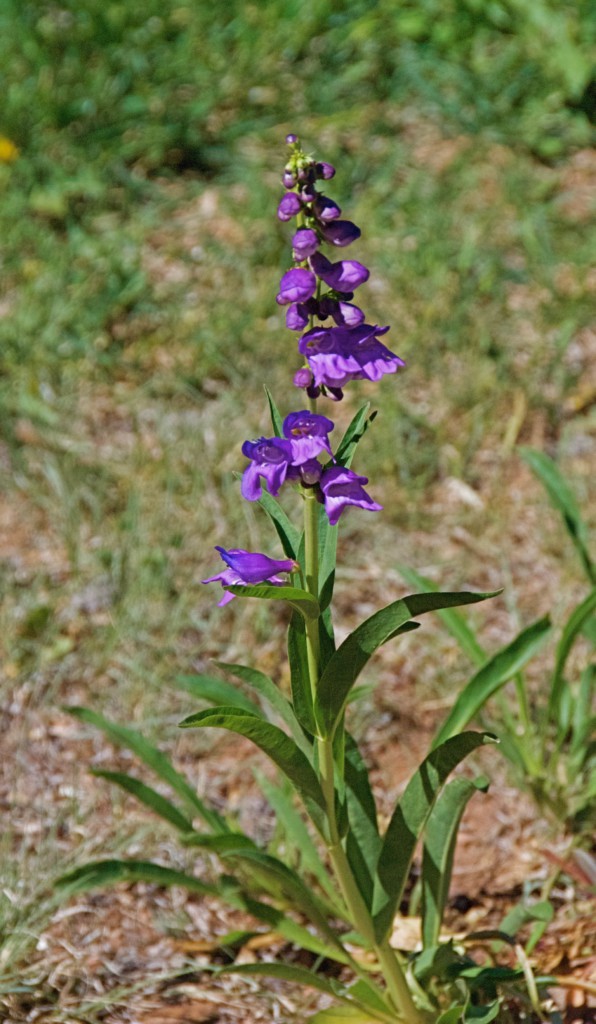
Note the sets of flower clusters on the spike. Photo by Janice Tucker.
The Rocky Mountain penstemon’s woody caudex anchors a basal clump of slender, dark green leaves from which erect stems rise to a height of 1-3 feet. The opposite leaves become smaller as they ascend upwards, eventually giving way to terminal spikes consisting of several flower clusters, each containing 2 to 4 deep purple to light blue blossoms. The corolla’s two upper petals extend like a canopy over the 3 longer and deeply lobed lower petals that bend slightly downward. Curved, white stamens – 4 fertile, 1 infertile – topped with hairy, purplish anthers protrude from the corolla’s deep throat. Once all the flower components come together, the resulting image resembles an open mouth with the hairy anthers serving as the tongue. Hence the common name of beardtongue.
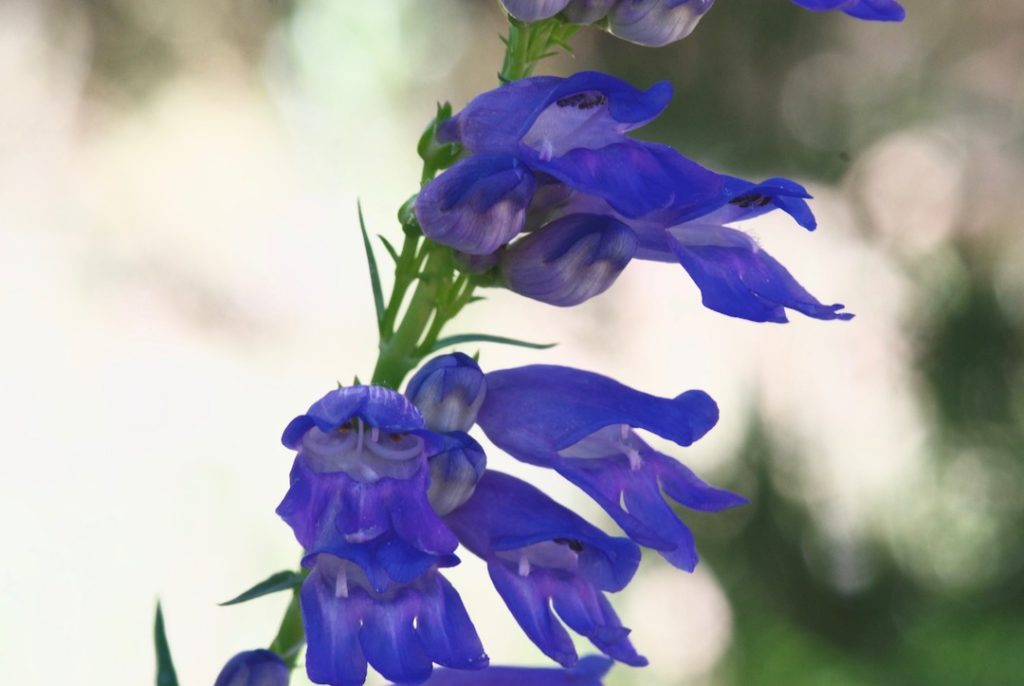
Close up of P. strictus flowers. Photo by Janice Tucker
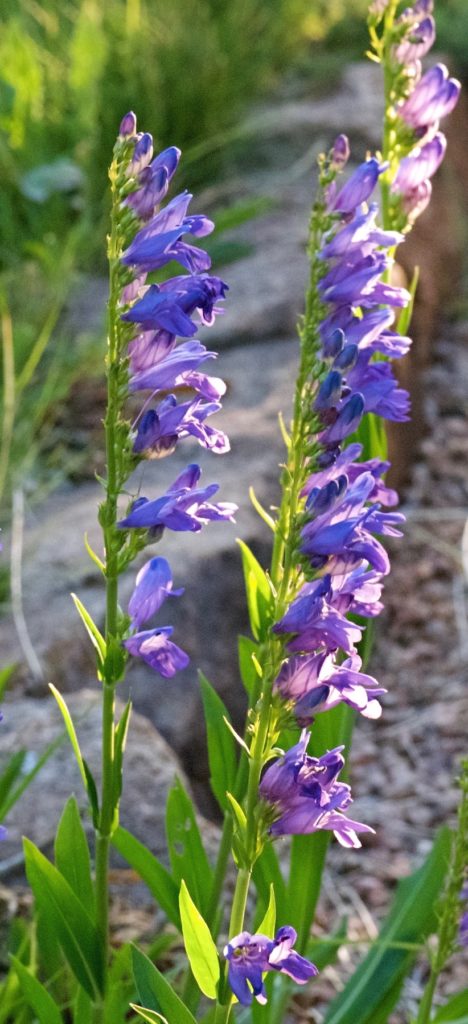
Rocky Mountain penstemon secund arrangement. Photo by Janice Tucker.
Another identifying characteristic is the arrangement of the Rocky Mountain penstemon’s flowers that usually appear on only one side of the flower spike (secund). A closer examination will reveal that the flowers actually grow on both sides. The tiny, flower stems (pedicels) on one side will wrap over the spike to fall in line with the flowers on the opposite side, creating a floral display of asymmetrical elegance.
Gardeners are known for their love of tending to plants but they are also inclined to favor those that respond in kind. And even more appreciated are those plants, once established, take the initiative to thrive without high maintenance. The Rocky Mountain penstemon, which grows best in USDA Zones 4-9, fits that description to a T. It is a long-lived, native perennial equipped with all the necessities for dealing with high altitudes and dry climates. Hummingbirds, butterflies and bees are drawn to its nectar and rabbits don’t seem to have it on their menu. The Rocky Mountain penstemon spreads by stolons, naturalizing in clump-like stands. It easily propagates from seeds that have been cold-stratified. Plant in spring, summer or fall. For guidance on where to plant the Rocky Mountain penstemon, look no further than its natural habitat where it grows either in the dappled shade of a woodland or soaks up the sun in an open field. It prefers dry, well-drained soil that is not over-rich with nutrients, so lay off the fertilizer. After the initial watering to establish the Rocky Mountain penstemon, it demands no more than the measly moisture allotted by the weather gods in our area. Cutting off the spent flower stalks will keep a neat appearance. However, if re-seeding is desired, leave a few stalks for that purpose. The Rocky Mountain penstemon is not overly aggressive and mingles well with neighboring plants. This is evident from observing where they grow naturally, often preferring to be near other wildflowers.
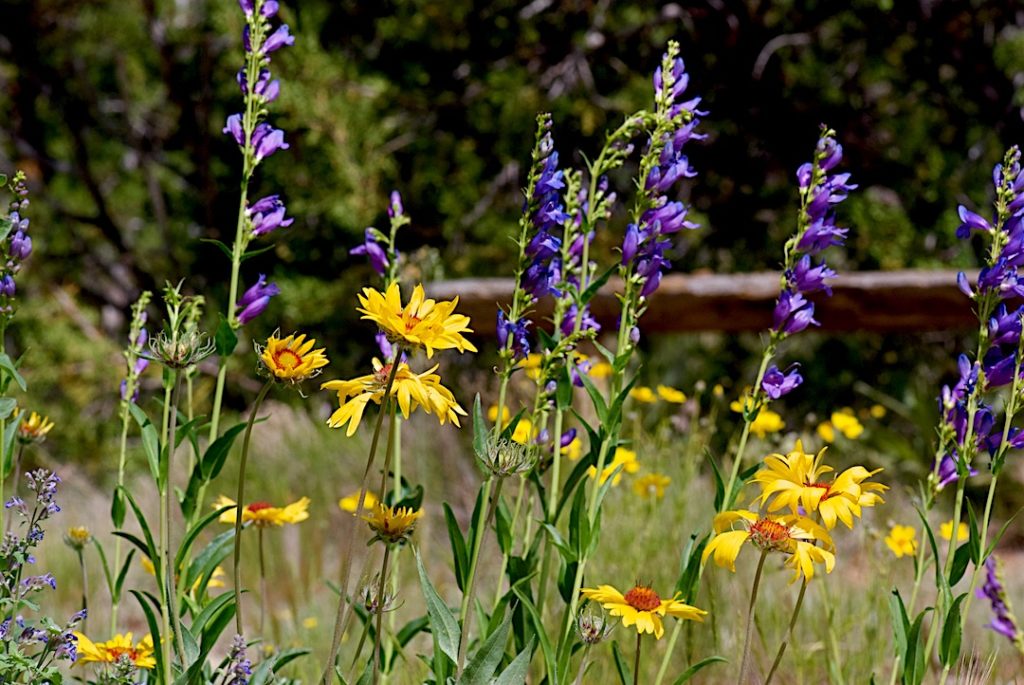
Wild P. strictus and Gaillardia in natural habitat. Photo by Janice Tucker.
The positive experience with the Rocky Mountain penstemon may entice gardeners to incorporate more Penstemon species or cultivars into flower beds and other landscaped areas. Since there are over 300 Penstemon species and a gazillion hybrids and cultivars, local nurseries can help with pairing the best varieties for a specific plant zone. Horticulturists have developed Penstemon cultivars with extended bloom time, which is great news for flower-aholics. Since it is helpful to see established plants prior to installing them in your garden, take notice of the various Penstemon species that grow naturally in our area. In addition to the P. strictus, wild Penstemons such as the stately, pink P. palmeri, the brilliant, red P. barbatus and the lavender P. jamesii put on quite a show in Santa Fe every spring and summer. Want to see a larger selection of Penstemons and how they behave in a garden setting? The Botanical Garden at Museum Hill in Santa Fe, New Mexico, features 27 varieties of Penstemons growing in several locations. The P. jamesii also flourishes in its natural habitat with other drought tolerant plants in the upland plant zone on the South Trail at Santa Fe Botanical Garden’s Leonora Curtin Wetland Preserve.
Penstemon is from the Greek, defined as, “having 5 stamens”. There is some confusion regarding who named the genus. But John Mitchell (1711-1768), an American colonial physician and botanist, is credited with publishing the first scientific description, although it is unclear if he was describing the genus or a species. Named by English botanist George Bentham (1800-1884), the species, strictus, is from the Latin, meaning “erect”. This description most likely refers to the stems or the growth habit even though the stems of the P. strictus sometimes tend to lean a bit.
For many, many years, the Penstemon genus resided in the large figwort/snapdragon (Scrophulariaceae -skrof-yoo-larr-ee-AY-see-ee) family. Then DNA testing arrived on the scene, turning the taxonomy world on its head! The Scrophulariaceae family, with 275 genera was shattered. Its genera were scattered, relocating them into several other plant families. Depending on which source is believed, the current Scrophulariaceae genera count is anywhere between 62 and 87. The small plantain (Plantaginaceae – plan-ta-JIN-aye-see-ee) family that had only 3 genera experienced quite a population explosion. After the dust settled, it ended up with 120 genera, including the Penstemons. But even with the passing of several years since DNA testing resulted in this particular plant reclassification, many online sources still list the Penstemon species in the Scrophulariaceae family. There must be some debating among taxonomists going on here. One other oddity regarding plant names and family classification needs to be addressed. The banana-like plant commonly known as plantain is not genetically related to any species in the plantain family. Generically named Musa x paradisiaca, is as one would expect, in the banana (Musaceae) family. Since in this instance plantain is the common name, we can’t pin this anomaly on taxonomists.
Penstemons have a history of some medicinal uses, but often the success – and safety – of the treatment depends upon pairing the species with the remedy. With over 300 species and goodness knows how many hybrids and cultivars, it could take ages to narrow down which Penstemon is the correct species to use. Best to ignore vague folk remedies of that sort. However, a poultice made from freshly crushed Penstemon flowers or leaves is considered a safe treatment for relieving irritation from superficial injuries such as bruises, cuts and insect bites.
Our lovely city of Santa Fe, New Mexico, is ensconced between the Rocky Mountains’ southern ranges of the Sangre de Cristo and Jemez Mountains, with the highest peak reaching an elevation above 13,000 feet. It is well documented that the showy Penstemon strictus has a penchant for cozying up to the sky at altitudes of 6,500 to 11,000 feet. So it can be said that for Santa Feans hooked on wildflowers, the Penstemon strictus is – figuratively and literally – “a Rocky Mountain high”. (With apologies to the late John Denver.)
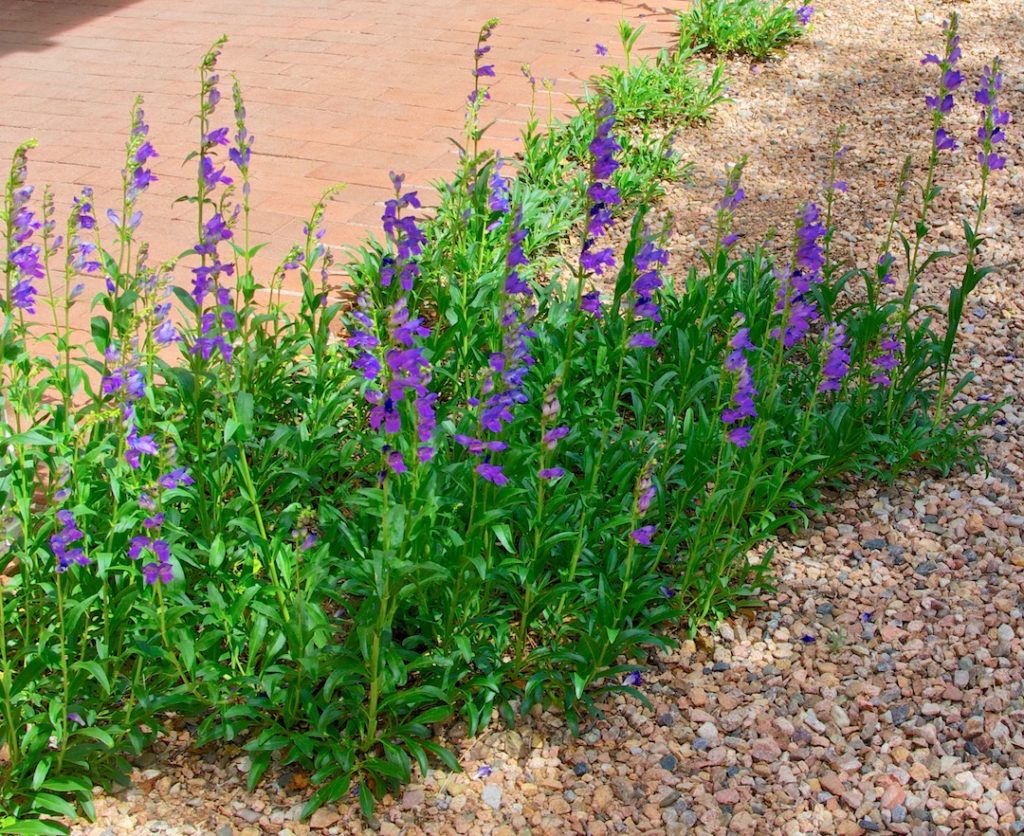
Rocky Mountain penstemon in a home garden. Photo by Janice Tucker.
Many thanks to Helen Woody and Jeanne Gozigian for proofreading this article.
Sources Consulted:
Elpel, Thomas J. “Plantaginaceae Plants of the Plantain Family”. Web World Portal. 2017. Accessed 20 Jan. 2019. Retrieved from: https://www.wildflowers-and-weeds.com/Plant_Families/Plantaginaceae.htm.
“George Bentham (1800-84)”. Springer Nature. Web. 2019. Accessed 20 Feb. 2019. Retrieved from: https://www.nature.com/articles/134351b0.
“John Mitchell (geographer)”. Wikipedia. 8 May 2018. Web. Accessed 21 Feb. 2019. Retrieved from:
https://en.wikipedia.org/wiki/John_Mitchell_(geographer).
Lindgren, Dale and Wilde, Ellen. Growing Penstemons: Species, Cultivars and Hybrids. American Penstemon Society. Haverford, Pennsylvania: Infinity Publishing.com, 2003. Print.
Moore, Michael. Medicinal Plants of the Mountain West. Santa Fe, New Mexico: Museum of New Mexico Press, Revised and Expanded Edition, 2001. Print.
“Penstemon”. Wikipedia. 2 Jan. 2019. Web. Accessed 21 Feb. 2019. Retrieved from: https://en.wikipedia.org/wiki/Penstemon .
“Penstemon strictus”. Garden Explorer. Santa Fe Botanical Garden. 2019. Web. Accessed 18 Feb. 2019. Retrieved from:
https://santafebotanicalgarden.gardenexplorer.org/taxon-552.aspx .
“Penstemon strictus”. Native Plants Database. Lady Bird Johnson Wildflower Center. 18 Apr. 2009. Web. Accessed 21 Jan. 2019. Retrieved from: https://www.wildflower.org/plants/result.php?id_plant=pest2.
“Penstemon strictus, Rocky Mountain Penstemon”. The American Southwest. Web. Accessed 21 Jan. 2019. Retrieved from:
http://www.americansouthwest.net/plants/wildflowers/penstemon-strictus.html .
“Penstemon strictus, Rocky Mountain Beardtongue”. High Country Gardens. 2019. Web. Accessed 21 Jan. 2019. Retrieved from:
https://www.highcountrygardens.com/perennial-plants/penstemon/penstemon-strictus.
Phillips, Judith. New Mexico Gardener’s Guide. Franklin, Tennessee; Cool Springs Press. 1998. Print.
“Plantaginaceae”. The Plant List. 2013. Web. Accessed 18 Feb. 2019. Retrieved from:
http://www.theplantlist.org/1.1/browse/A/Plantaginaceae/.
“Scrophulariaceae”. The Plant List. 2013. Web. Accessed 18 Feb. 2019. Retrieved from:
http://www.theplantlist.org/1.1/browse/A/Scrophulariaceae/.
Schneider, Al. “Penstemon strictus”. Southwest Colorado Wildflowers. 2019. Web. Accessed 21 Jan. 2019. Retrieved from:
SEINet Portal Network. 2019. “Penstemon strictus”. http//:swbiodiversity.org/seinet/index.php . Accessed 21 Jan. 2019.
Stearn, William T. Stearn’s Dictionary of Plant Names for Gardeners. London, England: Cassell Wellington House, Orion Publishing, Reprinted with new Preface. 2004. Print.


